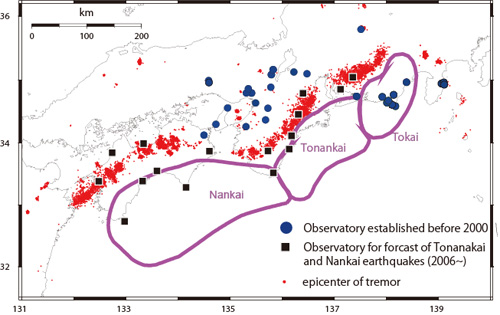 Tectono-Hydrology Research Group
Tectono-Hydrology Research Group
We conduct observation of groundwater and crustal deformation and analysis of those data toward short- and intermediate-term forecast of the Nankai megathrust earthquake. AIST has been monitoring groundwater level and discharge rate to promote the anticipated Tokai earthquake under the Act on Special Measures for Large-scale Earthquakes since the late 1970s, and has been providing observation data and results of the analysis to Japan Meteorological Agency (JMA). Recently, non-volcanic deep tremors and short-term slow slip events were discovered and have been recursively observed every 3-8 months at the deeper area of the plate boundary with respect to the focal zones of the Nankai megathrust earthquake. Monitoring these tremors and slip events could be helpful for the short- and intermediate-term forecast of the Nankai megathrust earthquake. Since 2006, AIST established new observatories for the purpose of forecast of the Tonankai and Nankai earthquakes in and around the Shikoku, Kii peninsula and Tokai regions. At the new observatories AIST started not only groundwater observation but observation of crustal deformation and earthquake, and AIST has also started exchanging observation data with National Research Institute for Earth Science and Disaster Prevention (NIED) and JMA in real-time basis. We perform development of observation and analysis methods to provide details of non-volcanic deep tremors and short-term slow slip events promptly. These will be useful to improve forecast accuracy of the Nankai megathrust earthquake.

Hypothetical focal zones of the Tokai, Tonankai and Nankai earthquakes,
and location of AIST observatories
Member
- Yuichi Kitagawa (Leader, Group)
- Satoshi Itaba (Senior Researcher)
- Tadafumi Ochi (Senior Researcher)
- Suguru Yabe (Senior Researcher)
- Kohei Shimotsuma (Research Assistant)
- Norio Matsumoto (Technical Staff)
- Ayako Takahashi (Technical Staff)
- Tsutomu Sato (Senior Researcher) (concurrent)
I research the mechanism of groundwater changes associated with earthquakes. I have improved and validated the poroelastic theory using the observation data of groundwater responses to earthquake and crustal deformation. Recently, I contributed to construction of the AIST observatories in and around the Tokai, Kii peninsula, and Shikoku regions along the Nankai Trough and have been detecting short-term slow slip events using the observation data of groundwater and crustal deformation for monitoring of slips on the plate boundary.
For the purpose of forecasting the Nankai megathrust earthquake , I am currently studying slow slip events on the plate boundary. For high-precision monitoring of the slow slip events, I am developing analysis methods of geodetic data and technique of high-sensitivity borehole strain observation.
Monitoring crustal deformation in southwestern Japan(SWJ) by various types of geodetic data, and modeling temporal changes of interplate coupling and slow slip on the plate interface. At this point, I mainly analyzed daily GNSS data and inferred spatial distribution and variation of the coupling and the slow slip along Suruga-Nankai trough. Now I'm trying to reveal the whole picture of interplate coupling and slow slip in SWJ analyzing the old geodetic data such as leveling and tidal data.
I have studied tectonic tremor activities (seismic signals of "Slow Earthquake") in Nankai trough with seismic data (Hi-net, F-net, DONET, etc.). I want to understand the source physics of slow earthquake through revealing patio-temporal variations of tectonic tremor activities.
I have conducted development of time series analysis for groundwater data, estimation of groundwater-level anomalies associated with hypothetical preslip prior to the anticipated Tokai earthquake and in-situ calibration method of borehole strainmeter. I will perform time series analysis of borehole strain/tilt data and development of analysis methods for short-term slow slip events to contribute the forecast of the Nankai megathrust earthquake.

